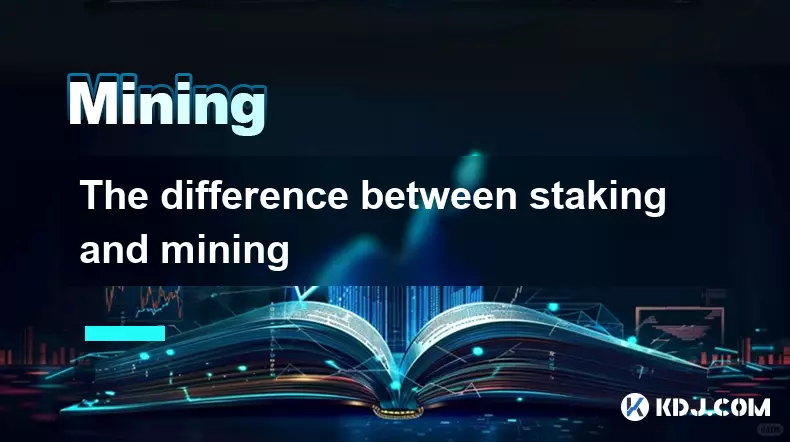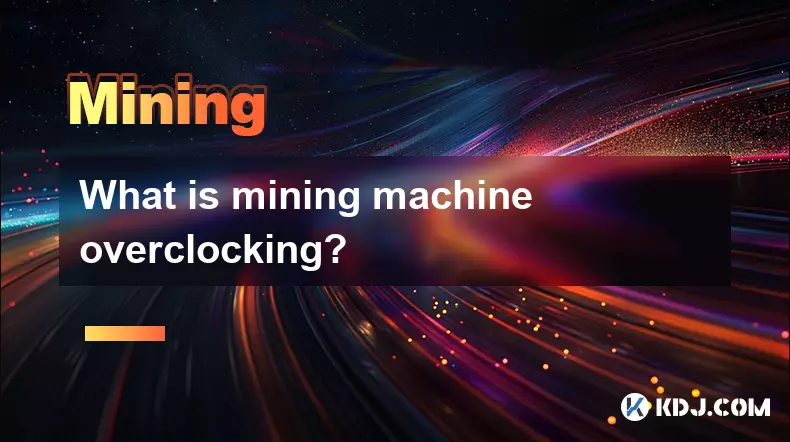-
 bitcoin
bitcoin $124586.364639 USD
0.62% -
 ethereum
ethereum $4670.671710 USD
3.33% -
 xrp
xrp $2.983701 USD
0.18% -
 tether
tether $1.000175 USD
-0.03% -
 bnb
bnb $1209.430642 USD
2.76% -
 solana
solana $231.365861 USD
0.51% -
 usd-coin
usd-coin $0.999665 USD
-0.02% -
 dogecoin
dogecoin $0.264657 USD
4.46% -
 tron
tron $0.346415 USD
1.60% -
 cardano
cardano $0.871586 USD
3.70% -
 chainlink
chainlink $23.451270 USD
7.56% -
 hyperliquid
hyperliquid $46.860071 USD
-2.96% -
 ethena-usde
ethena-usde $1.000120 USD
0.04% -
 sui
sui $3.611279 USD
1.08% -
 stellar
stellar $0.407149 USD
0.96%
What is hashrate and how can I increase it?
Hashrate measures mining power, with higher values increasing block reward chances and network security.
Aug 08, 2025 at 12:22 am

Understanding Hashrate in Cryptocurrency Mining
Hashrate is a fundamental metric in cryptocurrency mining that measures the computational power used to process transactions and secure blockchain networks. It represents the number of hashes per second that a mining device can perform. Each hash is a unique output generated by running data through a cryptographic hash function, such as SHA-256 used in Bitcoin. The higher the hashrate, the more attempts a miner makes to solve the cryptographic puzzle required to add a new block to the blockchain. This directly influences the probability of earning block rewards.
For example, a hashrate of 1 TH/s (terahash per second) means the hardware can perform one trillion hash calculations every second. Networks like Bitcoin operate with hashrates in the exahash range (EH/s), indicating the immense collective power of global miners. The hashrate is not only crucial for individual profitability but also reflects the overall security of the blockchain—higher network hashrate makes it more difficult for malicious actors to execute a 51% attack.
Factors That Influence Individual Hashrate
Several hardware and software factors determine the hashrate an individual miner can achieve. The most significant is the mining hardware used. ASICs (Application-Specific Integrated Circuits) are purpose-built for mining and offer vastly superior hashrates compared to GPUs or CPUs. For instance, a modern Bitcoin ASIC might deliver 100 TH/s, while a high-end GPU may only achieve 50 MH/s on Ethereum’s algorithm before its transition to proof-of-stake.
Other influencing factors include:
- Hardware configuration: Overclocking settings, voltage adjustments, and firmware optimization.
- Cooling efficiency: Excessive heat throttles performance, reducing effective hashrate.
- Power supply stability: Inconsistent power delivery can cause instability and lower hash output.
- Mining pool software: Efficient software minimizes downtime and maximizes hash submission rates.
Ensuring each of these components is optimized allows a miner to extract the maximum possible hashrate from their equipment.
Choosing the Right Mining Hardware
To increase hashrate, selecting appropriate hardware is the first critical step. For Bitcoin mining, ASIC miners such as the Bitmain Antminer S19 Pro or the MicroBT WhatsMiner M50S are industry standards. These devices are optimized for SHA-256 hashing and deliver high efficiency in terms of joules per terahash.
When evaluating hardware, consider:
- Hashrate rating: Check manufacturer specifications under standard conditions.
- Power efficiency: Measured in joules per terahash (J/TH); lower values mean better efficiency.
- Cost-to-performance ratio: Balance upfront cost with expected hashrate and longevity.
- Availability and delivery time: Some high-demand models may have long waitlists.
For altcoins using different algorithms (e.g., Ethash, KawPow), GPU mining rigs remain relevant. A rig with multiple high-performance GPUs like the NVIDIA RTX 4090 can yield significant hashrate when properly configured. Always verify compatibility between the coin’s hashing algorithm and your hardware.
Optimizing Hardware Settings for Maximum Hashrate
After acquiring suitable hardware, fine-tuning its settings can substantially increase effective hashrate. This process involves accessing the miner’s firmware or control panel—often via a web interface or command-line tool.
Key optimization steps include:
- Overclocking the GPU or ASIC chip: Increasing core clock and memory clock (for GPUs) can boost hash output. Use tools like MSI Afterburner for GPUs.
- Adjusting voltage: Lowering voltage can improve efficiency, but too low may cause instability.
- Tweaking intensity and thread concurrency: These settings affect how aggressively the hardware processes hashing tasks.
- Flashing custom BIOS or firmware: Some miners use modified firmware (e.g., VBIOS for GPUs) to unlock higher performance, though this carries risk.
Always monitor temperature and stability during adjustments. Use mining software such as HiveOS or NiceHash OS to apply and test configurations remotely. Perform stress tests to ensure the system maintains the increased hashrate without crashing or errors.
Software and Pool Configuration for Efficient Hash Submission
Even with powerful hardware, poor software setup can lead to rejected shares and reduced effective hashrate. Mining software acts as the bridge between your hardware and the mining pool. Popular options include CGMiner, BFGMiner, and PhoenixMiner for GPU setups, and vendor-specific tools for ASICs.
To ensure optimal performance:
- Select a reliable mining pool: Choose one with low latency, high uptime, and minimal rejected shares.
- Configure server regions close to your location: This reduces ping and improves share submission speed.
- Use efficient mining protocols: Stratum V1 or V2 offers better communication between miner and pool.
- Monitor rejected share rate: Keep it below 1%. High rejection rates indicate network or configuration issues.
Configure your miner with the correct pool URL, port, and worker credentials. For example, in CGMiner, the command might look like:
--url stratum+tcp://pool.example.com:3333 --user worker_name --pass xRegularly update mining software to benefit from performance improvements and bug fixes.
Environmental and Maintenance Considerations
Sustaining high hashrate over time requires attention to the physical environment. Mining hardware generates substantial heat, and inadequate cooling leads to thermal throttling—automatically reducing performance to prevent damage.
Implement the following:
- Ensure proper ventilation: Use exhaust fans or dedicated mining racks with airflow management.
- Maintain ambient temperature below 25°C: Cooler environments enhance hardware efficiency.
- Clean dust regularly: Dust buildup insulates components, increasing operating temperatures.
- Use industrial-grade power supplies: Stable voltage prevents fluctuations that impact hashrate.
Periodic maintenance, such as reapplying thermal paste on ASICs or checking GPU fan speeds, ensures consistent performance.
Frequently Asked Questions
Q: Can internet speed affect my hashrate?A: Internet speed does not directly impact the number of hashes your hardware computes. However, a slow or unstable connection can cause delayed share submissions to the mining pool, resulting in a higher rate of rejected shares. This reduces your effective hashrate as fewer contributions are accepted. Aim for at least 10 Mbps download and 5 Mbps upload with low latency.
Q: Is it possible to increase hashrate without upgrading hardware?A: Yes, through software optimization and overclocking. Adjusting GPU core and memory clocks, tuning voltage, and using efficient mining software can yield 10–20% gains. Ensure cooling is adequate to handle the increased load. Firmware updates or switching to a more efficient mining pool can also help.
Q: Why does my hashrate drop after a few hours of mining?A: This is often due to thermal throttling. As components heat up, they automatically reduce performance to stay within safe temperature limits. Check cooling systems, clean dust from fans and heatsinks, and consider improving room ventilation. Monitoring tools like HWInfo can help identify temperature spikes.
Q: Does joining a larger mining pool increase my hashrate?A: No, pool size does not change your hardware’s hashrate. However, larger pools offer more consistent payout distribution due to higher collective hashrate, reducing variance in reward frequency. Your individual contribution (hashrate) remains the same regardless of pool size.
Disclaimer:info@kdj.com
The information provided is not trading advice. kdj.com does not assume any responsibility for any investments made based on the information provided in this article. Cryptocurrencies are highly volatile and it is highly recommended that you invest with caution after thorough research!
If you believe that the content used on this website infringes your copyright, please contact us immediately (info@kdj.com) and we will delete it promptly.
- BlockDAG, DOGE, HYPE Sponsorship: Crypto Trends Shaping 2025
- 2025-10-01 00:25:13
- Deutsche Börse and Circle: A StableCoin Adoption Powerhouse in Europe
- 2025-10-01 00:25:13
- BlockDAG's Presale Buzz: Is It the Crypto to Watch in October 2025?
- 2025-10-01 00:30:13
- Bitcoin, Crypto, and IQ: When Genius Meets Digital Gold?
- 2025-10-01 00:30:13
- Stablecoins, American Innovation, and Wallet Tokens: The Next Frontier
- 2025-10-01 00:35:12
- NBU, Coins, and Crypto in Ukraine: A New Yorker's Take
- 2025-10-01 00:45:14
Related knowledge

The difference between staking and mining
Sep 24,2025 at 05:18am
Understanding Staking in the Cryptocurrency Ecosystem1. Staking involves holding funds in a cryptocurrency wallet to support the operations of a block...

How to participate in testnet mining?
Sep 22,2025 at 09:18am
Understanding Testnet Mining in the Crypto Ecosystem1. Testnet mining is a method used by blockchain developers to simulate real-world conditions on a...

How to dispose of abandoned mining machines?
Sep 19,2025 at 08:19pm
Assessing the Condition of Abandoned Mining Rigs1. Begin by inspecting each mining machine for visible damage, corrosion, or missing components. Machi...

How to identify high-quality mining pools?
Sep 21,2025 at 03:19pm
Reputation and Track Record1. A mining pool’s reputation is built over time through consistent performance and transparency. Pools that have operated ...

Advantages of decentralized mining pools
Sep 20,2025 at 04:36pm
Enhanced Security and Resistance to Censorship1. Decentralized mining pools operate on blockchain-based smart contracts, eliminating the need for a ce...

What is mining machine overclocking?
Sep 21,2025 at 07:19pm
Understanding Mining Machine Overclocking1. Mining machine overclocking refers to the process of increasing the operating frequency of a cryptocurrenc...

The difference between staking and mining
Sep 24,2025 at 05:18am
Understanding Staking in the Cryptocurrency Ecosystem1. Staking involves holding funds in a cryptocurrency wallet to support the operations of a block...

How to participate in testnet mining?
Sep 22,2025 at 09:18am
Understanding Testnet Mining in the Crypto Ecosystem1. Testnet mining is a method used by blockchain developers to simulate real-world conditions on a...

How to dispose of abandoned mining machines?
Sep 19,2025 at 08:19pm
Assessing the Condition of Abandoned Mining Rigs1. Begin by inspecting each mining machine for visible damage, corrosion, or missing components. Machi...

How to identify high-quality mining pools?
Sep 21,2025 at 03:19pm
Reputation and Track Record1. A mining pool’s reputation is built over time through consistent performance and transparency. Pools that have operated ...

Advantages of decentralized mining pools
Sep 20,2025 at 04:36pm
Enhanced Security and Resistance to Censorship1. Decentralized mining pools operate on blockchain-based smart contracts, eliminating the need for a ce...

What is mining machine overclocking?
Sep 21,2025 at 07:19pm
Understanding Mining Machine Overclocking1. Mining machine overclocking refers to the process of increasing the operating frequency of a cryptocurrenc...
See all articles










































































